Giant Blu-ray Movie
HomeGiant Blu-ray Movie 
Warner Bros. | 1956 | 201 min | Rated G | Nov 05, 2013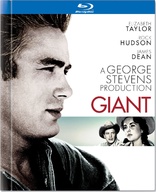
Movie rating
7.7 | / 10 |
Blu-ray rating
| Users | 3.6 | |
| Reviewer | 4.5 | |
| Overall | 3.9 |
Overview
Giant (1956)
Jordan 'Bick' Benedict Jr., is a wealthy landowner and cattle rancher who marries a spoiled and wealthy Virginian woman. When the two return to his cattle empire in Texas, conflicts around race, class and changing traditions including former cowboy and now rich oil tycoon Jett Rink rise to epic proportions through the years and test the unity of the family and surrounding community.
Starring: Elizabeth Taylor, Rock Hudson, James Dean, Carroll Baker, Jane WithersDirector: George Stevens (I)
| Drama | Uncertain |
| Romance | Uncertain |
| Western | Uncertain |
Specifications
Video
Video codec: MPEG-4 AVC
Video resolution: 1080p
Aspect ratio: 1.66:1
Original aspect ratio: 1.66:1
Audio
English: DTS-HD Master Audio 2.0 Mono (48kHz, 24-bit)
French: Dolby Digital Mono
German: Dolby Digital Mono
Italian: Dolby Digital Mono
Spanish: Dolby Digital Mono
Spanish: Dolby Digital Mono (Spain)
Portuguese: Dolby Digital Mono
Czech: Dolby Digital Mono
Polish: Dolby Digital Mono
Japanese: Dolby Digital Mono
Japanese is hidden
Subtitles
English SDH, French, German SDH, Italian SDH, Japanese, Portuguese, Spanish, Czech, Danish, Finnish, Hebrew, Korean, Mandarin (Simplified), Norwegian, Polish, Romanian, Swedish, Turkish
Discs
50GB Blu-ray Disc
Three-disc set (1 BD, 2 DVDs)
Playback
Region A (B, C untested)
Review
Rating summary
| Movie | 5.0 | |
| Video | 4.0 | |
| Audio | 4.0 | |
| Extras | 4.5 | |
| Overall | 4.5 |
Giant Blu-ray Movie Review
Gone with the Oil
Reviewed by Michael Reuben November 8, 2013(Note: This review is based on the James Dean Ultimate Collector's Edition, which contains the same Blu-ray disc with different packaging.) James Dean's last film, Giant, signaled a new direction in the actor's career and offered a tantalizing glimpse of the promise that was cut short when he died in a car wreck on September 30, 1955, at the age of 24. (Dean had filmed all his scenes for Giant, but fellow cast member Nick Adams had to overdub a few lines.) Instead of riding the wave of his new-found fame in another star vehicle, Dean took a supporting role in a prestige project helmed by one of Hollywood's top directors, George Stevens, fresh off the success of Shane (1953) and already an Oscar winner for A Place in the Sun (1951). The script, by long-time Stevens associate Ivan Moffat, was based on Edna Ferber's bestselling novel, and Dean played someone who, while initially sympathetic, would end up as the villain of the piece. It was a character role, the kind of work for which Dean had prepared at the Actors Studio in New York. He seemed to relish the opportunity to transform himself into someone else. If not for Dean's untimely death, Giant would probably not be included as part of a "James Dean collection", but when a legend leaves only three films, every one of them counts. Despite Dean's memorable turn as Jett Rink, Giant belongs to its two leads, Rock Hudson and Elizabeth Taylor. It's the romance and often tempestuous marriage between their two characters that is the most consistent element in Stevens' sprawling epic spanning thirty years in the history of Texas and, indirectly, the nation. Like Gone with the Wind, to which it is often compared, Giant portrays sweeping events from the viewpoint of individuals, whose emotional lives give these historical moments a specific gravity that headlines and abstractions cannot possibly convey. Stevens' challenge as a director was that Giant lacks a single definitive event around which to organize the story, as the Civil War so neatly structured Gone With the Wind. To this day, I suspect that scholars and budding filmmakers still study Giant trying to decipher how Stevens managed to make a three hour and seventeen minute film in which characters and plot lines come and go, criss-crossing and interweaving in a fashion that even the enthusiastic participants on the commentary track call "meandering" (and one of them is the screenwriter). Somehow, though, the massive narrative keeps pulling the viewer forward, as fortunes change, characters grow old, some die and others are born and mature into adults. By the end of Giant, you feel that you've been somewhere and stayed a while. Maybe it was that extra year that Stevens spent in the editing room, turning a deaf ear to the pleas of studio head Jack Warner to please, please, please finish the picture, which was already hugely over budget and had missed several release windows. Stevens was that rare director who had the intestinal fortitude and, at that point in his career, the industry clout, to insist on holding Giant until he was satisfied. Eventually Warner was made whole. Giant premiered in October 1956 to rave reviews and spectacular box office. The film was nominated for ten Oscars and won Stevens the second of his two directing statues. Everyone expected it to win Best Picture, but in one of those famously second-guessed Oscar votes, it lost to Around the World in Eighty Days, whose producer, Michael Todd, has been described as "the Harvey Weinstein of his day".
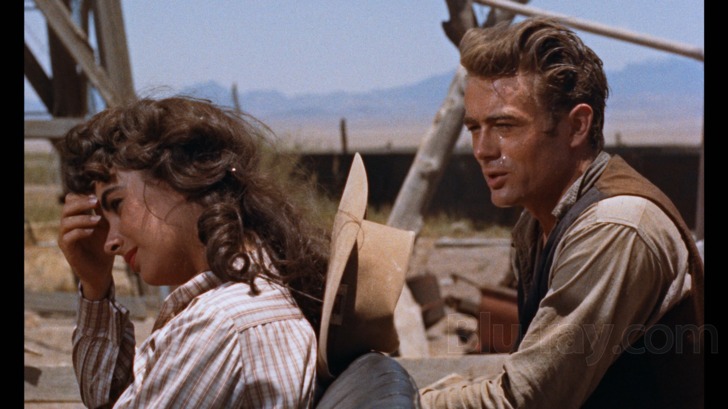
Giant is a film of opposites. One of the most obvious is between the dusty, open spaces of western Texas, where Jordan "Bick" Benedict (Hudson) owns one of the largest ranches in the state and the more populated greenery of Maryland, where Bick goes to acquire a prize stallion, War Winds. In addition to the horse, he also acquires the owner's daughter, Leslie Lynton (Taylor), as a wife. Bick is lovestruck from their first meeting, when he sees Leslie riding the spirited War Winds with obvious ease. Leslie quickly becomes fascinated with the rough-hewn Texan, who is nothing like the self-satisfied society men she's known, of which her current fiancé, Sir David Karfrey (Rod Taylor), is a prime example. A new life awaits Leslie when she returns with Bick to Reata, Bick's cattle ranch of over half a million acres, and the giant mansion that Bick shares with his sister, Luz (Mercedes McCambridge), who is tough, weatherbeaten and possessive. The mansion is one of Giant's iconic images. Simultaneously spooky and stately, it rises out of the Texas plain with nothing around it, reaching for the sky in much the same manner as the oil derricks that will later transform the land and the skyline. Luz is none too pleased that her brother has married, and Bick is none too pleased to find that Luz has retained the services of Jett Rink (Dean), a ne'er-do-well whom Bick had fired. As Leslie quickly learns, Texas too has its social hierarchy. Wealthy landowners like her husband occupy the top rung. Men like Jett with no land and no family sit near the bottom. But even further down are the Mexicans who work the Benedict land and, if they're lucky, act as servants in the house. They live in abject poverty in hovels on the ranch. Over the next thirty years, as Bick and Leslie age and raise three children, various conflicts will alternately push them together and pull them apart, and key issues will rise and rise again in different forms. One of Giant's distinctive qualities is the apparent ease—I say "apparent", because this kind of storytelling takes much careful planning and pacing—with which Stevens allows themes and storylines to play for a while, then recede until it's time for them to return. Early on, for example, Leslie Benedict squares off against her husband over his treatment of his Mexican workers, and the subject remains a source of marital discord for years. Not until the very end of Giant does Bick Benedict soften his position on the status of Mexicans, for reasons that I will let first-time viewers discover on their own. The result is a visceral and even shocking sequence that still catches viewers by surprise. Perhaps the single greatest conflict in Giant is the accelerating disappearance of the old Texas that Bick Benedict loves and his growing frustration at his inability to stem the tide of change coming at him from all sides. It's there when his wife insists that she's smart enough to be included in "man talk" about politics. (Leslie eventually withdraws, but not quietly.) It frustrates him to his core when not one of his three adult children shows any interest in assuming the mantle of the gentleman (or wife of a gentleman) rancher that Bick proudly inherited from his father and expects to see carried forward into the future under the Benedict name. (The children, played by Dennis Hopper, Carroll Baker and Fran Bennett, all have other plans.) And it's there especially in the drilling rigs that are transforming Bick's neighbors from ranchers into men of leisure who sit back and collect their lease payments from oil companies. Jett Rink comes to symbolize everything that Bick despises about oil. For reasons that Bick can never fathom, his sister Luz has a sentimental fondness for Jett and, through her good offices, he acquires a few acres of apparently worthless land in a corner of Reata. The scene in which Bick and several of his friends try to buy back the land from Jett is justly famous, because Dean has almost no lines but steals the scene by keeping everyone focused on Jett. What could he be thinking? Jett's refusal to sell his tiny parcel makes no economic sense in his current circumstances, but his instincts are sound. For the first time in his life, he's a landowner—and he won't let go of what's his. When Jett strikes oil on that parcel, his life is transformed; or is it? His first instinct after the gusher erupts is to drive directly over to the Benedict house, still covered in oil (in fact, it was molasses) to brag to Bick about his newfound wealth and flirt shamelessly with Leslie (to whom he has previously declared his admiration). "I'm gonna have more money than you ever thought you could have—you and all the rest of you stinkin' sons of... Benedicts!" he exults. The scene foreshadows Jett's entire future in the decades ahead, as he becomes a wealthy and admired business tycoon but remains a shell of a man, hollowed out by his unassuageable envy of the Benedicts and his desire to be Bick Benedict. All his wealth won't fill the hole at the center of his being, which will ultimately be his downfall. In the end, though, Jett Rink's personal failings are irrelevant to the larger economic forces of which he is merely a representative. Bick Benedict may be the better man, but the beloved world to which he brought a young bride at the beginning of Giant is rapidly vanishing around them. I have only sketched portions of Giant's rich tapestry, but the film is an elegy for the lively, energetic, independent spirit of the old Texas where cattle roamed free and ranchers were king. It was a place big enough to sustain the last vestiges of the frontier's pioneer spirit well into the 20th Century—the same spirit that Stevens captured so effectively in Shane—but eventually "progress" catches up everywhere. Giant is paced to let you experience the sensation of "progress" just as the Benedicts might have felt it, both the good and the bad.
Giant Blu-ray Movie, Video Quality 
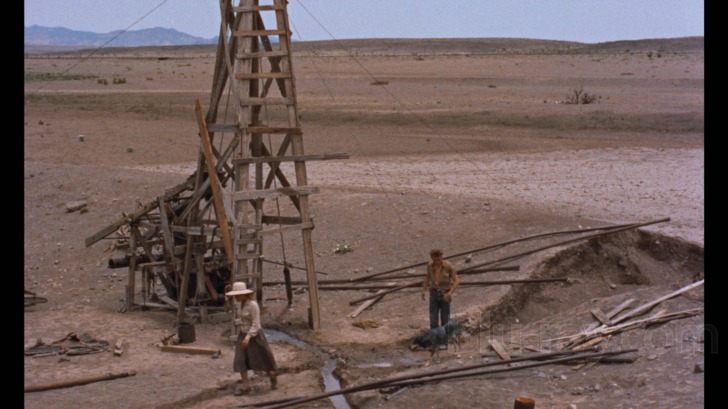
For Giant, Stevens reunited with his cinematographer from A Place in the Sun, William C. Mellor, who had shot the earlier film with diffusion and soft-focus lenses. Bucking the trend of the day, Stevens refused to shoot in the currently fashionable widescreen format of Cinemascope, partly because he believed that height was critical to Giant's imagery, and partly because he was dissatisfied with the visual distortions created by Cinemascope's anamorphic lenses, which remained a work in progress. (These distortions, sometimes known as "mumps syndrome", are the reason why still frames from East of Eden and Rebel Without a Cause strike some viewers as "stretched".) Having recently been through the experience with Paramount of having Shane matted for widescreen projection, although it was framed and shot for the standard Academy ratio of 1.37:1, Stevens was well aware of how Giant would be shown. Nevertheless, he and Mellor apparently shot the film at 1.66:1, which is the aspect ratio on Warner's 1080p, AVC-encoded Blu-ray. For an American film, 1.66:1 is a problematic ratio, because it cannot be the "original aspect ratio" if one goes by projection standards of which the typical theater is capable. By the time of Giant's premiere, theaters in the U.S. had largely settled on a standard of 1.85:1 for non-anamorphic projection. Nevertheless, Warner and MPI have elected to present Giant on Blu-ray at 1.66:1. All evidence indicates that this was Stevens' preference. Since no image appears to have been lost and none of the compositions appear (to my eye) to have been compromised, I am unconcerned by this decision and have not taken it into account in scoring the video. Like the other two films in the James Dean collection, Giant was taken from a 4k scan of the negative (according to Warner), then restored and color-corrected by MPI. Given MPI's general reputation and their performance on East of Eden and Rebel Without a Cause, one must assume that they have extracted the best image from Giant that the source could possibly yield. Still, there will be many complaints that the image is "soft", "blurry" or indistinct. Certainly, as compared to something like East of Eden, Giant lacks the same level of sharpness. I am advised that certain shots were beyond repair and had to be taken from dupes; these are, for obvious reasons, among the softest and blurriest in the film. In addition, the film is filled with optical effects, primarily dissolves, that further reduce the quality of the source. Giant does not, however, lack for detail or vivid color. The former is readily visible in innumerable scenes, including, for example, the adobe slum where Leslie Benedict hops out of the jeep in which she is riding to look in on a sick Mexican mother and her equally sick baby, or the elaborate banquet thrown by Jett Rink in his own honor at his swanky new hotel. The colors show up in the women's wardrobes, then again in the hues that begin to brighten the Benedict mansion at Reata as oil money raises their standard of living. Fine detail is not the only measure of a high-quality image. Stevens used color in Giant as much as (or more than) any other visual element to compose the frame and direct the eye. As Stevens, Jr. relates in the commentary, because Giant did not use Technicolor but "Eastmancolor" (his term; the credits say "Warnercolor"), considerable care had to be taken to get certain shades to Stevens' liking, especially the greens. MPI has, of course, repaired any damage or wear-and-tear wherever possible, and the film's natural grain has been preserved without filtering, sharpening or other unnatural tampering. The average bitrate of 21.95 Mbps is on the low side, but Giant is a long film. Fortunately, there are enough scenes of stillness and conversation to allow conservation of bits for the more demanding sequences.
Giant Blu-ray Movie, Audio Quality 

Giant's original mono soundtrack is presented as two-channel lossless DTS-HD MA, with identical left and right front channels, and it sounds quite good. Scattered throughout the extras are references to specific examples of the care with which the sound was mixed: volume raised on an actor's lines to make him dominate the scene, or the blows of one participant in a fight amplified to convey the impression that he was winning. The Blu-ray's track captures such subtle, often subliminal effects and also more overtly narrative sounds like horses galloping, cattle being herded, the relentless machinery of Jett Rink's oil rigs, etc. The dialogue is always clear, which is an important point for a George Stevens film. The majestic, often thundering score by Dmitri Tiomkin, a crucial component of Giant's epic sweep, is conveyed with decent fidelity and good dynamic range. Barring a stereo remix from original stems, I doubt that it could sound better.
Giant Blu-ray Movie, Special Features and Extras 
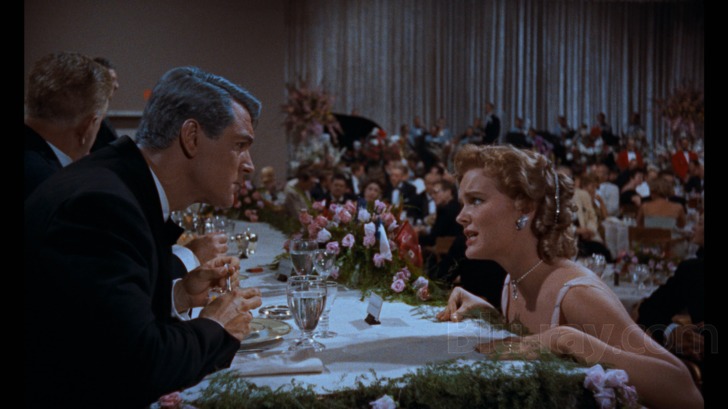
Most of the extras are contained on two DVDs. The first copies the supplemental disc included with Warner's 2004 two-disc special edition of Giant. The second is devoted to the 1984 full-length documentary biography of George Stevens by his son. Blu-ray Features
- Introduction by George Stevens, Jr. (480i; 1.33:1; 2:55): Recorded in 1995, Stevens, Jr. provides an optional introduction summarizing various points that will be covered in greater depth in the remaining extras.
- Commentary with George Stevens, Jr., Screenwriter Ivan Moffat and Film Critic Stephen Farber: As with Shane, Stevens served as an uncredited production assistant on Giant. He and Moffat provide a wealth of insights, memories and trivia, although much of it is duplicated in the other extras. Farber acts as informal moderator, prompting Stevens and Moffat with questions. Even with three participants, however, it proves difficult to keep up a continuous commentary for over three hours. An alert listener will notice that some portions of the commentary in the last half hour are literally replays of earlier sections (e.g., Stevens' comments on Michael Todd and the Oscar results).
- George Stevens: Filmmakers Who Knew Him (480i; ; 1.33:1; 45:40): First released in 2001 on the DVD of A Place in the Sun, this documentary features revealing interviews with an impressive array of notables, including Warren Beatty, Frank Capra, Rouben Mamoulian, Joseph L. Mankiewicz, Alan J. Pakula, Robert Wise and Fred Zinneman.
- Memories of Giant (1.33:1; 51:36): This 1998 documentary features interviews with George Stevens, Jr., Carroll Baker, Earl Holliman, Jane Withers and, in archive footage, Rock Hudson, Elizabeth Taylor, James Dean and George Stevens. Chapter headings are listed below:
- 1. Recalling George Stevens
- 2. Casting the Leads
- 3. Train to Marfa
- 4. First-Day Hangover
- 5. Elizabeth Taylor
- 6. Rock Hudson
- 7. James Dean
- 8. Carroll Baker
- 9. Earl Holliman
- 10. George Stevens, Jr.
- 11. Marfa Nightlife
- 12. Country Club Sundays
- 13. Taking Care of Dean
- 14. Dean's Death
- 15. Pink Keepsake
- 16. A Film to Last
- Return to Giant (1.33:1; 55:07): This 2003 documentary is narrated by Don Henley and features many of the same participants as "Memories of Giant", along with additional cast members and various Texans, from Marfa and surrounding environs. If the documentary has a weakness, it's over-reliance on clips from the film.
- 1. Eye on Marfa
- 2. Casting
- 3. The Landscape
- 4. More than Watchers
- 5. Rope Tricks
- 6. Hudson and Taylor
- 7. Striking Oil
- 8. Recreation
- 9. Filming Over
- 10. Tragedy
- 11. As We See Ourselves
- 12. Proud Legacy
- 13. End Credits
- New York Premiere Telecast (1.33:1; 28:51): Chill Wills hosts a red carpet event from the Roxy Theater.
- Hollywood Premiere (1.85:1; 4:21): A news report that opens with a recap of the New York premiere, then provides coverage of the Hollywood opening at Grauman's Chinese Theater.
- Giant Stars Are Off to Texas (1.33:1; 0:38): A brief Warner Pathe News item.
- Stills and Documents: The "stills" are a collection of behind-the-scenes photos. The "documents" are excerpts from the internal correspondence during production, including the often contentious exchanges between Stevens and Jack Warner over such crucial elements as budget and the film's running time.
- Behind-the-Cameras: On Location in Marfa, Texas (1.33:1; 5:58): An installment of the EPK-like promotional TV series "Behind the Scenes" hosted and narrated by Gig Young. A few bits of location footage look staged, but most of it is obviously authentic.
- Behind-the-Cameras: A Visit with Dmitri Tiomkin (1.33:1; 6:33): Another installment of "Behind the Scenes" focusing on the work of Giant's composer. Gig Young interviews Tiomkin about his influences and background, and Tiomkin plays several of the key themes from Giant.
- Trailers
- 1956 "Book" Trailer (1.85:1; 1:33): So named because it has no film clips, only pages of a book that turn to reveal text and illustrations.
- Original 1956 Trailer (1.33:1; 3:45)
- 1963 Reissue Trailer (1.33:1; 2:29)
- 1970 Reissue Trailer (1.33:1; 3:03)
- A Giant Undertaking: A series of text screens providing an overview of Stevens' career, followed by apt quotations from Stevens, Hudson and Dean.
- George Stevens Filmography .
- Awards.
- Cast and Crew.
- Digibook.
- George Stevens: A Filmmaker's Journey (1.33:1; 1:51:24): This 1984 documentary, written, produced and directed by George Stevens, Jr., provides a detailed overview of the life and career of Giant's director. Beginning with his early days in Hollywood as a cameraman for Hal Roach, when Stevens saved Stan Laurel's career by figuring out how to photograph the future comedy legend so that his pale blue eyes would register on film, the documentary traces Stevens' long career directing such skillful light fare as Alice Adams (with Katherine Hepburn), Swing Time (with Fred Astaire and Ginger Rogers) and Woman of the Year (with Hepburn and Spencer Tracy). World War II changed Stevens' outlook. Volunteering for military service (along with such notables as William Wyler, Frank Capra and John Ford), Stevens was assigned by General Eisenhower to document the Normandy invasion. Later, he directed a film crew that recorded the liberation of the concentration camp at Dachau. He returned from four years of war having lost all interest in comedy or anything else on the lighter side. Indeed, for several years, Stevens seemed uninterested in directing at all. With I Remember Mama in 1948, Stevens began the series of films that would bring him two Oscars for Best Director, great popular success and major industry clout. The list includes Giant, A Place in the Sun and Shane. The winning streak ended in 1965, with the troubled production of The Greatest Story Ever Told, starring Max von Sydow as Jesus. It was during this period that Stevens became embroiled in an infamous controversy within the Directors Guild of America, when Cecil B. DeMille, a staunch anti-Communist and supporter of the blacklist, attempted to remove Joseph L. Mankiewicz as president and to institute loyalty pledges. Stevens led the successful opposition, although, as recounted by Fred Zinneman and John Huston, it was the venerable John Ford who stood up at a key moment and delivered the coup de grace. The documentary uses substantial archival footage, including recordings of Stevens himself, and its interviewees are an impressive roster, many of whom are no longer with us. In addition to Hepburn, Zinneman and Huston, participants include: Joel McCrea, Douglas Fairbanks, Jr., Fred Astaire, Ginger Roger, Millie Perkins, Frank Capra and Alan Pakula (whose stories about Shane are brief but memorable).
Giant Blu-ray Movie, Overall Score and Recommendation 
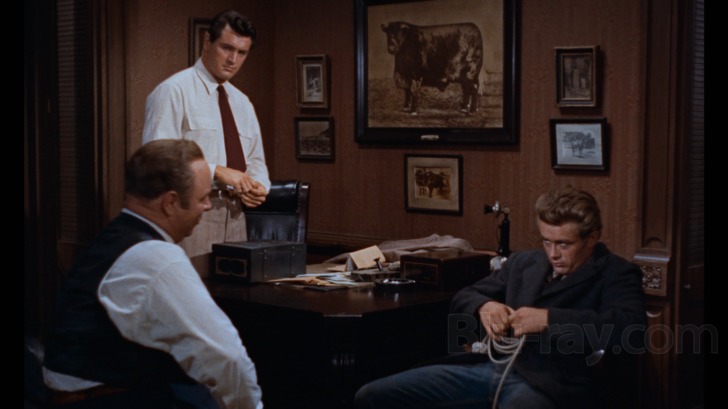
Whether one wants to regard it as a James Dean film, a George Stevens film or a Rock Hudson / Elizabeth Taylor film, Giant remains one of the essential works of 20th Century cinema, a testament to the ability of a stubbornly individual talent to produce major work within the Hollywood system. It's a film of big events, but it's also filled with tiny moments and subtle interactions that only reveal themselves on subsequent viewings—and thanks to this new Blu-ray presentation, these can now be appreciated better than ever before on home video. Highly recommended.
Similar titles
Similar titles you might also like

Rebel Without a Cause 4K
1955

East of Eden
1955

Wild River
Fox Studio Classics
1960

Stanley & Iris
1990

Guess Who's Coming to Dinner
50th Anniversary Edition
1967

The Landlord
1970

Amira & Sam
2015

Imitation of Life
1959

The Searchers 4K
Warner Archive Collection
1956

Grand Hotel
1932

The Magnificent Ambersons
1942

Imitation of Life
1934

My Beautiful Laundrette
1985

Desert Hearts
1985

Forty Guns
1957

Saturday Night and Sunday Morning
1960

Mississippi Masala
1991

The Fugitive Kind
1960

Duel in the Sun
Roadshow Edition
1946

All That Heaven Allows
1955

